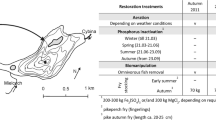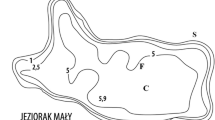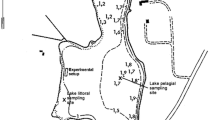Abstract
Phytoplankton, zooplankton, submerged vegetation and main nutrients have been monitored in 48 eutrophic ponds from the Brussels Capital Region (Belgium) between 2005 and 2008. Nine ponds have been biomanipulated in order to improve their ecological quality and prevent the occurrence of noxious cyanobacterial blooms. The 4-year study of a large number of ponds allowed identification of the factors having the strongest influence on phytoplankton growth. Continuous monitoring of the biomanipulated ponds allowed the significance of changes caused by biomanipulation to be tested as well as the main reasons of biomanipulation successes and failures to be elucidated. The main factors controlling phytoplankton in the ponds studied appeared to be grazing by large cladocerans and inhibition of phytoplankton growth by submerged vegetation. Biomanipulation resulted in a significant decrease in phytoplankton biomass in general and biomass of bloom-forming cyanobacteria in particular that were associated with a significant increase in large Cladocera density and size. In six out of nine ponds biomanipulation resulted in the restoration of submerged vegetation. The maintenance of the restored clearwater state in the biomanipulated ponds was strongly dependent on fish recolonisation and nutrient level. In the absence of fish, the clearwater state could be maintained by submerged vegetation or large zooplankton grazing alone. In case of fish recolonisation, restoration of extensive submerged vegetation could buffer, to a considerable degree, the effect of fish except for ponds with high nutrient levels.
Similar content being viewed by others
References
Benndorf, J., Wissel, B., Sell, A. F., Hornig, U., Ritter, P., & Böing, W. (2000). Food web manipulation by extreme enhancement of piscivory: An invertebrate predator compensates for the effects of planktivorous fish on a plankton community. Limnologica-Ecology and Management of Inland Waters, 30, 235–245.
Blindow, I., Hargeby, A., Wagner, B. M. A., & Andersson, G. (2000). How important is the crustacean plankton for the maintenance of water clarity in shallow lakes with abundant submerged vegetation? Freshwater Biology, 44, 185–197.
Carpenter, S. R. (2005). Eutrophication of aquatic ecosystems: Bistability and soil phosphorus. PNAS, 102, 10002–10005.
Carpenter, S. R., Cole, J. J., Hodgson, J. R., Kitchell, J. F., Pace, M. L., Bade, D., et al. (2001). Trophic cascades, nutrients, and lake productivity: Whole-lake experiments. Ecological Monographs, 71, 163–186.
Descy, J.-P., Pirlot, S., Vernier, G., Lara, Y., Wilmotte, A., Vyverman, W., et al. (2009). Cyanobacterial blooms: Toxicity, diversity, modelling and managment. Report B-Blooms 2 (p. 56). Namur, Gent, Liege, Brussels, Dundee: FUNDP, UGent, ULg, University of Dundee, VUB.
Gliwicz, Z. M. (1990a). Food thresholds and body size in cladocerans. Nature, 343, 638–640.
Gliwicz, Z. M. (1990b). Why do cladocerans fail to control algal blooms? Hydrobiologia, 200, 83–97.
Gulati, R., & van Donk, E. (2002). Lakes in The Netherlands, their origin, eutrophication and restoration: State-of-the-art review. Hydrobiologia, 478, 73–106.
Hasle, G. R. (1978). The inverted-microscope method. In A. Sournia (Ed.), Phytoplankton manual (pp. 88–96). Paris: UNESCO.
Hudnell, K. H. (2008). Cyanobacterial harmful algal blooms. New York: Springer.
Irfanullah, H. M., & Moss, B. (2005). A filamentous green algae-dominated temperate shallow lake: Variations on the theme of clearwater stable states? Archiv Fur Hydrobiologie, 163, 25–47.
Jeppesen, E., Jensen, J. P., Kristensen, P., Søndergaard, M., Mortensen, E., Sortkjaer, O., et al. (1990). Fish manipulation as a lake restoration tool in shallow, eutrophic, temperate lakes. 2. Threshold levels, long-term stability and conclusions. Hydrobiologia, 200, 219–227.
Jeppesen, E., Jensen, P. J., Søndergaard, M., & Lauridsen, T. L. (1999). Trophic dynamics in turbid and clearwater lakes with special emphasis on the role of zooplankton for water clarity. Hydrobiologia, 408/409, 217–231.
Jeppesen, E., Jensen, J. P., Søndergaard, M., & Lauridsen, T. L. (2005). Response of fish and plankton to nutrient loading reduction in eight shallow Danish lakes with special emphasis on seasonal dynamics. Freshwater Biology, 50, 1616–1627.
Jeppesen, E., Sondergaard, M., Meerhoff, M., Lauridsen, T. L., & Jensen, J. P. (2007). Shallow lake restoration by nutrient loading reduction—some recent findings and challenges ahead. Hydrobiologia, 584, 239–252.
Kemp, P. F., Sherr, B. F., Sherr, E. B., & Cole, J. J. (1993). Handbook of methods in aquatic microbial ecology. Boca Raton: Lewis Publishers.
Lammens, E. H. H. R. (1999). The central role of fish in lake restoration and management. Hydrobiologia, 395/396, 191–198.
Lauridsen, T. L., Jensen, J. P., Jeppesen, E., & Sondergaard, M. (2003). Response of submerged macrophytes in Danish lakes to nutrient loading reductions and biomanipulation. Hydrobiologia, 506, 641–649.
Magnuson, J. J., Tonn, W. M., Banerjee, A., Toivonen, J., Sanchez, O., & Rask, M. (1998). Isolation vs. extinction in the assembly of fishes in small northern lakes. Ecology, 79, 2941–2956.
Moss, B. (2007). The art and science of lake restoration. Hydrobiologia, 581, 15–24.
Moss, B., Madgwick, J., & Phillips, G. (1996a). A guide to the restoration of nutrient-enriched shallow lakes. Norwich: Broads Authority.
Moss, B., Stansfield, J., Irvine, K., Perrow, M., & Phillips, G. (1996b). Progressive restoration of a shallow lake: A 12-year experiment in isolation, sediment removal and biomanipulation. Journal of Applied Ecology, 33, 71–86.
Moss, B., Stephen, D., Alvarez, C., Becares, E., Van de Bund, W., Collings, S. E., et al. (2003). The determination of ecological status in shallow lakes—a tested system (ECOFRAME) for implementation of the European water framework directive. Aquatic Conservation: Marine and Freshwater Ecosystems, 13, 507–549.
Paerl, H. W. (1988). Nuisance phytoplankton blooms in coastal, estuarine, and inland waters. Limnology and Oceanography, 33, 823–847.
Peretyatko, A. (2007) Phytoplankton dynamics in Eutrophic peri-urban ponds in relation to biotic and abiotic factors; implications for management and restoration. Ph.D. thesis. Brussels: Vrije Universiteit Brussel.
Peretyatko, A., Symoens, J.-J., & Triest, L. (2007a). Impact of macrophytes on phytoplankton in eutrophic peri-urban ponds, implications for pond management and restoration. Belgian Journal of Botany, 140, 83–99.
Peretyatko, A., Teissier, S., Symoens, J.-J., & Triest, L. (2007b). Phytoplankton biomass and environmental factors over a gradient of clear to turbid peri-urban ponds. Aquatic Conservation: Marine and Freshwater Ecosystems, 17, 584–601.
Peretyatko, A., Teissier, S., De Backer, S., & Triest, L. (2009). Restoration potential of biomanipulation for eutrophic peri-urban ponds: The role of zooplankton size and submerged macrophyte cover. Hydrobiologia, 634, 125–135.
Pinel-Alloul, B. (1995). Impacts des prédateurs invertébrés sur les communautés aquatiques. In R. Pourriot, & M. Meybeck (Eds.), Limnologie Générale (pp. 628–686). Paris: Masson.
Pourriot, R. (1995). Réponses adaptatives du zooplancton à la prédation. In R. Pourriot, & M. Meybeck (Eds.), Limnologie Générale (pp. 610–627). Paris: Masson.
Reynolds, C.S. (2006). Ecology of phytoplankton. Cambridge: Cambridge University Press.
Scheffer, M. (1998). Ecology of shallow lakes. Dordrecht: Kluwer Academic Publishers.
Scheffer, M., & Jeppesen, E. (1998). Alternative stable states. In E. Jeppesen, M. Sondergaard, M. Sondergaard, & K. Christoffersen (Eds.), The structuring role of submerged macrophytes in lakes (pp. 397–406). New York: Springer.
Scheffer, M., van Geest, G. J., Zimmer, K., Jeppesen, E., Søndergaard, M., Butler, M. G., et al. (2006). Small habitat size and isolation can promote species richness: Second-order effects on biodiversity in shallow lakes and ponds. Oikos, 112, 227–231.
Shapiro, J. (1990). Biomanipulation: The next phase—making it stable. Hydrobiologia, 200–201, 13–27.
Shapiro, J. (1995). Lake restoration by biomanipulation—a personal view. Environmental Reviews, 3, 83–93.
Shapiro, J., & Wright, D. I. (1984). Lake restoration by biomanipulation—round Lake, Minnesota, the first 2 years. Freshwater Biology, 14, 371–383.
Simons, J., Ohm, M., Daalder, R., Boers, P., & Rip, W. (1994). Restoration of Botshol (The Netherlands) by reduction of external nutrient load: Recovery of a Characean community, dominated by Chara connivens. Hydrobiologia, 275/276, 243–253.
Søndergaard, M., & Moss, B. (1998). Impact of submerged macrophytes on phytoplankton in shallow freshwater lakes. In E. Jeppesen, M. Sondergaard, M. Sondergaard, & K. Christoffersen (Eds.), The structuring role of submerged macrophytes in lakes (pp. 115–133). New York: Springer.
Søndergaard, M., Jensen, J. P., & Jeppesen, E. (2005a). Seasonal response of nutrients to reduced phosphorus loading in 12 Danish lakes. Freshwater Biology, 50, 1605–1617.
Søndergaard, M., Jeppesen, E., & Jensen, J.P. (2005b). Pond or lake: Does it make any difference? Archiv Fur Hydrobiologie, 162, 143–165.
Søndergaard, M., Jeppesen, E., Lauridsen, T. L., Skov, C., Van Nes, E. H., Roijackers, R., et al. (2007). Lake restoration: Successes, failures and long-term effects. Journal of Applied Ecology, 44, 1095–1105.
Sondergaard, M., Liboriussen, L., Pedersen, A. R., & Jeppesen, E. (2008). Lake restoration by fish removal: Short- and long-term effects in 36 Danish lakes. Ecosystems, 11, 1291–1305.
ter Braak, C. J. F., & Smilauer, P. (2002). CANOCO reference manual and user’s guide to Canoco for Windows: Software for canonical community ordination (Version 4.5). Ithaca: Microcomputer Power.
Tessier, A. J., & Woodruff, P. (2002). Cryptic trophic cascade along a gradient of lake size. Ecology, 83, 1263–1270.
van Donk, E., & van de Bund, W. J. (2002). Impact of submerged macrophytes including charophytes on phyto- and zooplankton communities: Allelopathy versus other mechanisms. Aquatic Botany, 72, 261–274.
Van Wichelen, J., Declerck, S., Muylaert, K., Hoste, I., Geenens, V., Vandekerkhove, J., et al. (2007). The importance of drawdown and sediment removal for the restoration of the eutrophied shallow Lake Kraenepoel (Belgium). Hydrobiologia, 584, 291–303.
Wetzel, G. R., & Likens, E. G. (1990). Limnological analyses. New York: Springer.
Willame, R., Jurczak, T., Iffly, J. F., Kull, T., Meriluoto, J., & Hoffmann, L. (2005). Distribution of hepatotoxic cyanobacterial blooms in Belgium and Luxembourg. Hydrobiologia, 551, 99–117.
Williams, P., Whitfield, M., Biggs, J., Bray, S., Fox, G., Nicolet, P., et al. (2003). Comparative biodiversity of rivers, streams, ditches and ponds in an agricultural landscape in Southern England. Biological Conservation, 115, 329–341.
Author information
Authors and Affiliations
Corresponding author
Rights and permissions
About this article
Cite this article
Peretyatko, A., Teissier, S., De Backer, S. et al. Biomanipulation of hypereutrophic ponds: when it works and why it fails. Environ Monit Assess 184, 1517–1531 (2012). https://doi.org/10.1007/s10661-011-2057-z
Received:
Accepted:
Published:
Issue Date:
DOI: https://doi.org/10.1007/s10661-011-2057-z




